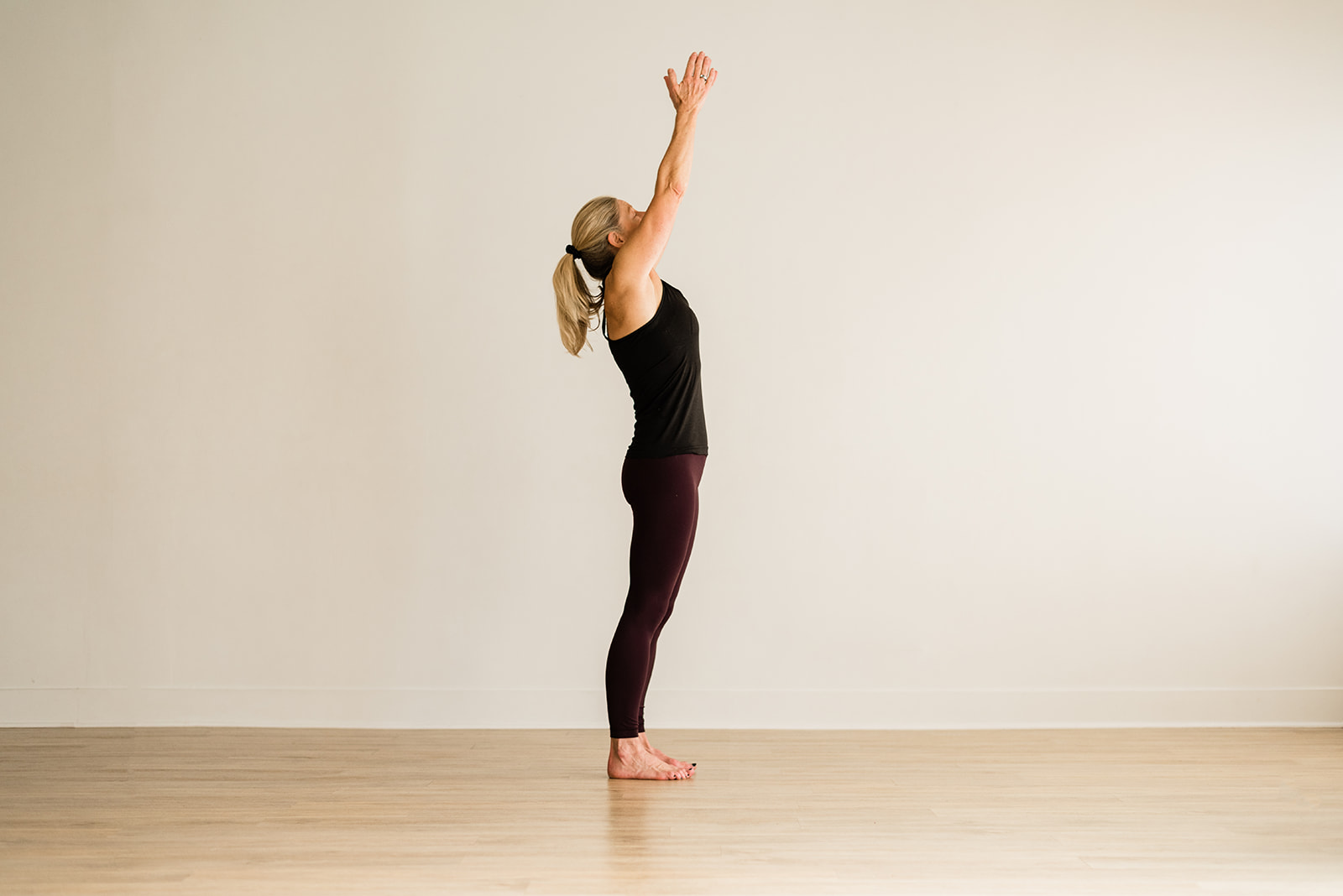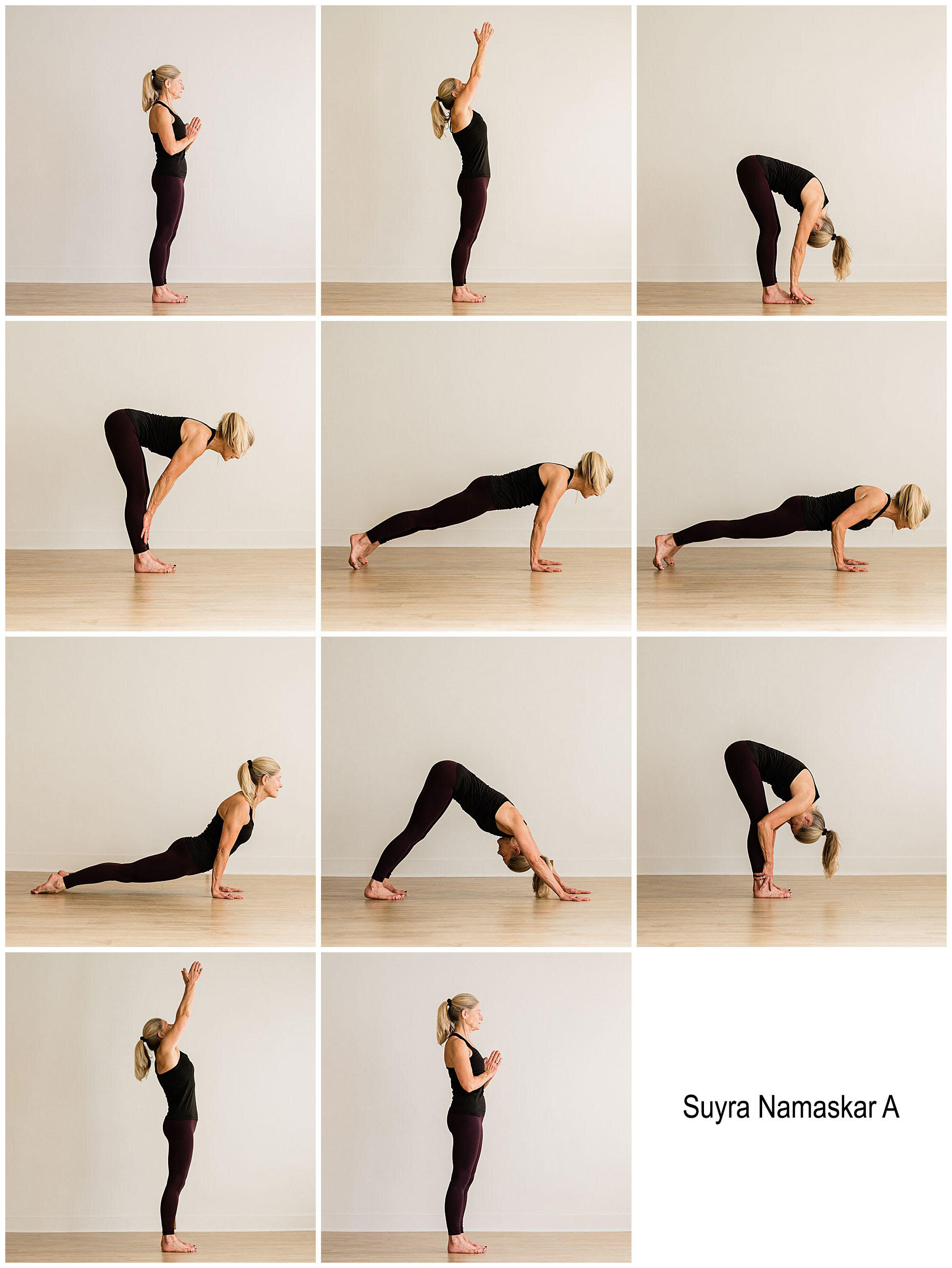Asana: Surya Namaskar A
Surya Namaskar A (“Sun Salute”)
by DANIELLE SHCUBERT
Photo Cred: @AlinaJack
The Sun Salutation to invoke warmth, integrity, and breath.
Surya Namaskar A (SNA, or commonly referred to as Sun Salutation A) is the backbone of many yogic practices. Traditionally practiced to greet the sun (Surya in Sanskrit), this dynamic, breath-driven practice invites us to bow to the light within while finding connection to the natural world around us. But as with many things in life, yogis share countless views on the history of this traditional set of poses. 2,500 years old, or a more modern adaptation reformulated in the 1920s? Due to Western influence and the individualization and diversification of Yoga, Surya Namaskar A variations are like pizza toppings; they abound to serve your body's unique, powerful palate. With that said, we'll flow through (oh, my humor has gotten dry, friends!) the traditional SNA poses with modifications.
An Honest Note About Modifications… I LOVE THEM! Not every day does the body want the athletic vigor of jumping back to Chaturanga Dandasana, nor will Upward Facing Dog always feel like joy. Cobra is there, knees can support you. So please remember, you can always SKIP the Vinyasa. 90 million Chanturangas do not a practice serve if the body is crying out, "No, thank you!" even when the ego asks for more. As we all well know, no pose is worth hurting the body.
The 11 Poses of Surya Namaskar A
*Please keep in mind, this is my traditional training with a background of Ashtanga, Viniyoga, and Iyengar. You will likely find another flavor of SNA as you venture through the wide, wonderful world of Yoga!
1. Tadasana - Mountain Pose.
Feel your feet on the ground. Feet start hips-width distance apart, heel behind the second toe. Inner thighs draw back while the tailbone lengthens to the floor. Spine is long, core is engaged, and the palms draw forward while the shoulder blades are flat on the back. Gaze (drishti) is soft, chin parallel to the floor.
*modifications: for tight hips, take the feet wider than hips-width distance apart.
2. Urdhva Hastasana in Tadasana - Upward Facing Hands in Mountain Pose. Root to rise.
While in Tadasana, with straight arms, inhale to sweep the arms overhead. Palms face one another, wrists over shoulders. Roll the inner arms back, space between the ears and upper shoulders.
*modifications: for tight shoulders, make a "Y" shape with the arms.
3. Uttanasana - Standing Forward Fold Pose. Surrender to self.
With thighs engaged and a long, neutral spine, exhale to hinge at the hips. Heart moves toward the knees, palms under the shoulders.
*modifications: for tight hamstrings, bend the knees. This does NOT have to be a straight-legged pose, as the emphasis is on the length of the neutral spine, not on whether you actually touch the floor.
4. Ardha Uttanasana - Half Standing Forward Fold Pose. Lengthen to touch all aspects of the world.
Inhale from Standing Forward Fold and lift half way, drawing the crown of the head forward to the front of the room, shoulder blades flat on the back, inner thighs engaged to protect the low back. Fingertips/palms either remain on the ground, shoulders over wrists, or palms to the sides of the shins. Emphasize drawing the crown of the head away from the tailbone, inviting and invoking length.
*modifications: for tight hamstrings, knees can be bent. Blocks can be placed under the palms under the shoulders to "lift" the ground up higher.
5. Chaturanga Dandasana - Four Limbed Staff Pose. Find joy and weightlessness in challenge.
Exhale from Ardha Uttanasana to bend the knees, plant the palms (shoulders over wrists) and lightly hop back to Chaturanga Dandasana. Landing in the "half-way float," elbows are over wrists, the spine is long. Shoulder blades are flat on the back (no rounding), while the inner upper arms draw along the sides of the torso. Elbows to the back of the room.
NOTE: I lovingly call Chaturanga the "White Whale" of the practice. Not only is it hands down one of the most challenging poses in our common practices, it is also taught the least safely and often executed incorrectly, putting the wrists, elbows, shoulders, and neck at risk. It's frequently rushed through by many for a reason: it's VERY hard to hold correctly, as it tests strength and stability in muscle groups we don't often use. There are VERY few people who have the core stability to jump back to plank, and it is NOT recommended. Imagine a car going over speed bumps at velocity without shocks . . . this is what happens to our neck when we don't bend the elbows (shock absorbers) or if we round the shoulder blades which overworks the upper Trapezius and not the Rotator Cuff muscles that must be engaged in order to jump back with integrity.
*modifications: if 90 million Chaturanga jump-backs strain your wrists, shoulders, elbows, or neck . . . SKIP IT! FREEDOM! Step back to plank and then push over the toes to lower half way on the exhale. Knees can also be placed on the mat when you lower to keep the shoulder blades flat on the back (cue Rotator Cuff muscles).
6. Urdhva Mukha Svanasana - Upward Facing Dog Pose. Crack open the heart fearlessly, but use your gut.
From Chaturanga, inhale to draw the heart forward, untuck the toes and begin to straighten the arms, maintaining shoulders over wrists. Spread the fingers, shoulder blades push into the chest. Tailbone is drawing to the hips-width distance heels, as all backbends are core driven to get out of the low back. Inner thighs are actively engaged, drawing up to the sky, as the quadriceps pull up off of the knees and float above the mat.
*modifications: Upward Facing Dog can always be substituted with Bhujangasana (Low/Baby Cobra Pose). Lowering to the floor from Chaturanga, untuck the toes, draw the palms by the side, thumbs by the side ribs. Elbows over wrists, the frontal hip points stay grounded on the mat as shoulder blades pull into the chest. Spread the collarbones, relax the jaw.
Backbends, or the extensions of the spine, often go into our most flexible areas (the Lumbar - low back, and the Cervical - the neck) if the core is not engaged. Keep the frontal hip points lifting toward the low ribs, actively drawing the tailbone down to the back of the heels.
7. Adho Mukha Svanasana - Downward Facing Dog Pose. Traction the spine to create a long line of energy.
Roll over the toes, exhale, supergluing the navel to the low back spine and hinge at the hips, drawing the upper inner thighs evenly to the back of the room. Feet are hips-width distance, palms shoulder-width distance, wrapping the triceps back, lifting the shoulder heads evenly away from the mat. Gazing softly towards the navel or the shins, core supports the traction of the spine. Ears remain by the upper inner arms.
*modifications: for tight hips, take feet wider than hips width. For tight shoulders, palms draw a few inches wider and can turn out very slightly. Knees can always stay bent for the hamstrings, or hands can be placed on blocks to alleviate tension or overworking of the shoulders.
8. Ardha Uttanasana - Half Standing Forward Fold Pose. Lift and lengthen, lead with the heart.
Ground down through the palms and, from Downward Dog, bend the knees deeply, engage the core and hop or lightly step to the top of the mat, inhaling in a half-way lift upon arrival. Feet are hips-width distance, shoulder blades flat on the back, core is engaged as the toes spread. Palms or fingertips on the mat shoulder-width distance or palms to the sides of the shins. Long spine.
*modifications: the step up to Ardha Uttanasana can happen in one movement (light hop) or in 12 baby steps if that's what works best for your body. Although the traditional Surya Namaskar is 1 breath / 1 movement, all of our bodies work differently. Make sure to listen to yours.
9. Uttanasana - Standing Forward Fold Pose. Heart to the knees, bow down to self.
Exhale to lengthen the spine, hinging at the hips. Weight is in the balls of the feet, drawing the sacrum towards the heels as the navel contracts.
10. Urdhva Hastasana in Tadasana - Upward Facing Hands in Mountain Pose. Reach out for something worth your time.
Ground down evenly through all four corners of the feet, lift the inner and outer arches, and while keeping the spine long and neutral (natural curves in the spine), use the inhale and the core to sweep the palms overhead. Wrists over shoulders, palms face one another at the top. Energy in the fingers is alive and purposeful.
11. Tadasana - Mountain Pose. Give back to the earth what doesn't serve you. You are not alone.
Feeling your feet on the ground, exhale to release the palms at the sides of the body, inner arms rolling forward, triceps drawing to the back of the room, ears over shoulders, hips over heels. Maybe close the eyes, paying attention to the sensation of breath with movement, heat in the core, and the earth supporting you under your feet.
*modifications: Hands can also draw toward the midline/heart for Namaste Mudra (Hands to Heart Pose for the hands). This is a personal preference, and we all teach/practice differently. Notice what is most authentic for you, even if it is different than your teacher or your neighbor.
Yoga asks us to move beyond the poses and their accomplishment, to surpass the ego that creates a gilded cage. Western Yoga often fixates on the completion of the pose, but would your practice change if the focus were on how it FEELS rather than how it LOOKS? Maintain your form (alignment over frequency) and find the joy in your breath (use it to nourish and cleanse). Take your time. Modify when the body says no. Ask for more when the body says yes. Authenticity over ego, always. In the end, it's not about those fancy "pretzel" poses on Instagram…. It's about honor, to self and to others.
“Yoga Citta' Vritti Nirodha.” (“Yoga is the stilling of the mind thought.”)
Catch Danielle's aligned, athletic classes at Metta Yoga
Corte Madera Tu/Th @815am Steady
Corte Madera W @6am Fiery
San Rafael - schedule coming soon
Want to take your Yoga off the mat? Join Danielle and the dynamic Amanda Snow for a life-changing week of Yoga, Culture, Food + Language in Florence, Italy, May 2020, YogaInItalia.com
IG @danielleschubert
© 2020 Metta Yoga LLC


